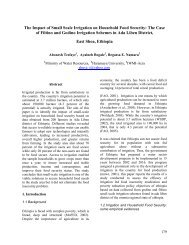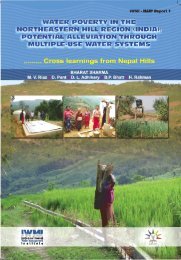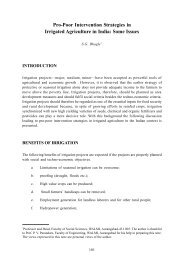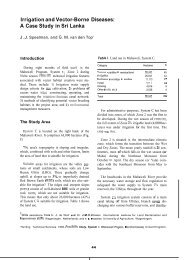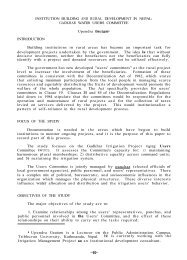A Case Study from System H, Sri Lanka
A Case Study from System H, Sri Lanka
A Case Study from System H, Sri Lanka
- No tags were found...
You also want an ePaper? Increase the reach of your titles
YUMPU automatically turns print PDFs into web optimized ePapers that Google loves.
Farmer-Oficer Coordination To Achieve Flexible Irrigation Scheduling 3In kwping with the unifii management system, a unified farmer organization system was also sct up, as against amultitude. of farmer organizations which prevailed in the earlier settlement phases, such as the Cultivation Committee,the Agricultural productivity Committee and the Rural Development Society.The farmers in each field channel (or turnout) were requested to organize themselves and elect a leader for theirturnout. This leader. and another farmer who WBS to be. the contact farmer for the fieldchannel organization, were to betrained by the project management. The field channel leader would deal with water distribution. and the contact farmer,with matters relating to agricultural extension.It was envisaged that with the passage of time the communities that were brought together within the settlement wouldneed a forum with a broader base than a turnout gmup organization to look after their affairs such as water management,agriculturalproduction,andreligious. socialandculturalactivities. TheMASLdecidedtoorganizeSettlerDevelopmentSocieties in every hamlet to fulfil these needs. All settlers over 18 years of age. were eligible to membership of the societyand the leaders of all the turnout groups in that hamlet would form the committee of the society together with arepresentative each of women and youth in that hamletThe MASL applied the unified system of management to all its seven project ams in operation at the time. There. are.threeprojectsin <strong>System</strong>H,oneeachin<strong>System</strong>sB andGandtwoin<strong>System</strong>C(Figure2). Allpm&tams.eachofwhichis headed by a Resident Project Manager, are. coordinated by the Mahaweti Economic Agency (MEA), which is thesettlement division of the MASL. The head of the ME4 was earlier called an Executive Dmtor but now the designationhas been changed to Managing Director, and he is appointed by the MASL. The ME4 consists of eight main divisionsas shown in Figure 3 i) irrigation, ii) agronomy, iii) marketing and credit, iv) community seMces. v) projectadministration, vi) lands, vii) adminis!ration. and viii) finance. A Chief Iriigation Engineer and a Senior Agronomist arein charge of their respective areas, and coordinate the projects with the Water Management Secrerariat of MASL onirrigation and agronomy (Figure 3).SETTLEMENT FEATURES IN THE MAHAWELI AREASEach settler is given an irrigated allotment of two and a half acres [I hectare (ha)] and a highland homestead allotmentof half an acre (0.2 ha). The irrigated lot is provided with a pipe inlet of 6-inch-diameter [I524 centimeters (cm)]. totake water <strong>from</strong> a field channel which takes off <strong>from</strong> a distributary. Each field channel consists of an average of 12-15standard allotments, but field channels vary <strong>from</strong> 6-22 allotments.The homesteads are. clustered into hamlets and located in suitable sites within close proximity to their respectivefarmlands. In selecting settlers for such hamlets, care has been taken to ensure. that. as far as possible, individualsallocated to one area are. selected <strong>from</strong> the same locality. A hamlet consists of 100-125 families, and4-5 such hamletsform a village center where the basic services for the farming population have been provided. About 2 4 such villagecenters were placed under the umbrella of a township, which caters to 3,000-5,000 families. The township was providedwith high level social infrastructure facilities such as post offices. multipurpose cooperative societies. hospitals etc.



